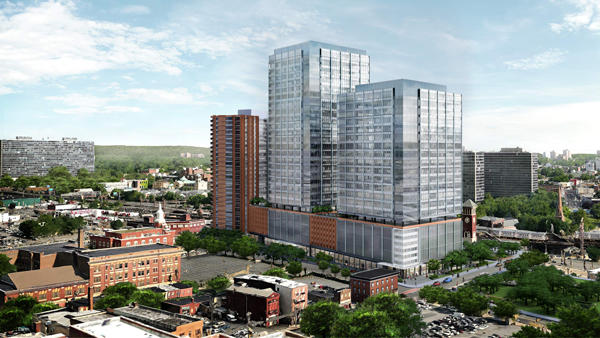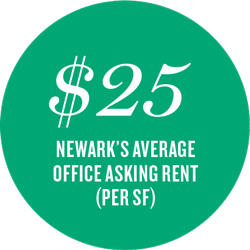Trending
Making the old new again
Aetna Realty and SJP Properties have teamed up to convert a four-acre industrial site into a mixed-use megaproject, but they aren’t the only ones making new inroads in Newark

Beaten down and brushed off for decades, Newark has bounced back in recent years, primarily due to the construction of apartment buildings. Developers have also added new retail and restaurants, and parks and streets around town have been spruced up.
But new office buildings, at least the kind that can accommodate a variety of tenants, have been largely missing. Until now.
Although taxes are high for businesses in New Jersey (now 11.5% for income over $1 million, thanks to a new line in the state’s budget), a flurry of recent development is offering tens of thousands of square feet of workplaces for firms that want to put down roots in New Jersey’s largest city. The latest offering is a megaproject on a nearly four-acre industrial site at Broad and Orange streets, which was announced this spring.
Newark’s bet on offices may seem counterintuitive. A high vacancy rate — a quarter of Newark’s offices are currently vacant, brokers said — suggests demand is tepid. But the real estate industry and city officials are confident that businesses sick of the suburbs are eager for a city address.
Rethinking Westinghouse
The megaproject at the former factory site on Broad may be the most ambitious development in the works in the city. On a weedy lot that was home to a Westinghouse plant that produced streetlamps, trolley motors and electric fans, the team of Aetna Realty and SJP Properties is planning a $1 billion, 2 million-square-foot mixed-use project that will cover an entire city block.
Many key details are still unknown, such as exactly how much of the site will be allocated to offices, but it could be up to 1 million square feet, a project spokesperson said. Located next to the city’s Broad Street train hub, it will also have hotel rooms, shops and apartments, according to Peter Bronsnick, the SJP senior vice president handling marketing. And housing units may even include condos, he added, a rarity in Newark.
There’s also no clear-cut timeline for the project, which is set to take shape at a site that has been fallow since the mid-1980s, when the Newark Works of the Westinghouse Company moved manufacturing to Florida. Aetna has controlled the site since then, and the main 400,000-square-foot red-brick structure, where the oldest section dated to 1894, was demolished in 2008.
SJP, based in Manhattan, has been active in Newark for years. Among its recent projects was a glassy 20-story tower developed for Prudential Financial. The company, which also helped build Panasonic’s U.S. headquarters at Two Riverfront Plaza, had spoken to Aetna over the years about a partnership, according Bronsnick, but their joint venture was finalized only this winter. No brokers were involved in the deal.
 The Westinghouse project, outside the downtown area, requires zoning permits, though City Hall — led by a pro-development mayor, Ras Baraka — is expected to grant them, brokers say.
The Westinghouse project, outside the downtown area, requires zoning permits, though City Hall — led by a pro-development mayor, Ras Baraka — is expected to grant them, brokers say.
But one potentially trickier sticking point is that Aetna and SJP hope to line up an office tenant before breaking ground. “In an ideal world, we would have one,” said Bronsnick, adding that “we are having strategic conversations in our marketing efforts with different groups.”
One possible tenant? Amazon, the Seattle-based e-tailer, which might select Newark as the location of its second headquarters. Newark is one of 20 finalists for the site, a project worth an estimated $5 billion and 50,000 jobs. The move could be a positive for the Garden State, Bronsnick said, but his attitude is wait and see. The project will go forth regardless.
Demand could also come from the immediate region. Corporations that have for years been sprawled in office parks in suburban locations are now interested in moving to cities that are well served by public transportation, brokers said. This enables firms to recruit young, high-quality workers from New York City.
Conversions
It’s not just the Westinghouse project that’s adding boardrooms.
Newark will also soon welcome Ironside Newark, a 1907 concrete-walled former warehouse near Newark’s Penn Station, which has been converted to a mixed-use building with 290,000 square feet of workspaces. This spring, Ironside, on Edison Place, snagged its first big tenant, Mars Wrigley Confectionery, which will take 150,000 square feet as it relocates its headquarters from Chicago, said Tim Greiner, an executive managing director with the commercial brokerage JLL and an agent for the building’s developer, Edison Properties.
Also at the property will be Edison itself, which will occupy 40,000 square feet when the building opens in November, Greiner said. A third tenant, which Greiner would not name, has signed a 7,200-square-foot lease, he added, making the seven-story building close to 70 percent rented in late June. Edison, which spent $80 million to redevelop the building — including adding windows and a penthouse level — is asking rents of $35 a square foot a year.
An owner of many parking lots in the metro region, as well Manhattan Mini Storage, Edison has taken stabs at new office buildings in Newark before.
In 2001, in a partnership with the Rockefeller Group, Edison was to build a 22-story tower on one of its lots by the Passaic River. At the time, Edison executives said the project needed a commitment from a major tenant before it could go forward. It’s unknown whether they got one, but the tower was never built.
Riverfront Square, a planned 12-acre mixed-use project from New York-based Lotus Equity Group at the one-time Newark Bears baseball stadium, is also placing an emphasis on office development. There were hopes for a baseball-fueled revival when it opened in 1999, but they were dashed when the stadium shuttered in 2013.
The 4.8 million-square-foot project will offer up to 2 million square feet of high-tech office space. First to open will be a 500,000-square-foot portion in a three-section building on Atlantic Avenue — and it’s made of engineered wood, not steel or concrete.
The offices at Riverfront Square, which also promises a hotel, shops and 2,000 apartments, are being marketed by Cushman &Wakefield, said Matt Lawyue, a project spokesperson. But an anchor tenant is needed before any shovels hit the ground, and the process of securing one might take a year, Lawyue said.
In addition, an Art Deco building at 540 Broad Street — where NJ Bell telephone company was formerly housed — is currently being converted. It’s slated to feature 80,000 square feet of office and retail space, plus 265 apartments. A team from L+M Development Partners is leading the effort.
Into the future
The developments are popping up in a city that appears to have one of the tighter office markets in northern New Jersey, though that might not be saying much.
Indeed, Newark’s overall office market has a stubbornly high vacancy rate, at 25 percent in the first quarter, according to an analysis by JLL, which also reported that the average annual asking rent is $25 a square foot.
Contemporary office space in Newark appears to be doing better, with a 16 percent vacancy rate, according to that JLL analysis. And average asking rents in that sector are about $34 a square foot annually.
In contrast, top-tier office buildings in the Hudson River submarket, which includes the towers on the waterfront in Jersey City that have been popular with Manhattan transplants for years, have about a 19 percent vacancy rate, according to JLL, and $42 a foot annual asking rents.
So far, the co-working trend, which has left places like New York with office vacancies as companies downsize, has not hit New Jersey. And experts said companies are looking to get out of the office park and back into cities.
“It seems like everybody is considering an urban location right now,” said JLL’s Greiner. “If you build it, they will come.”




